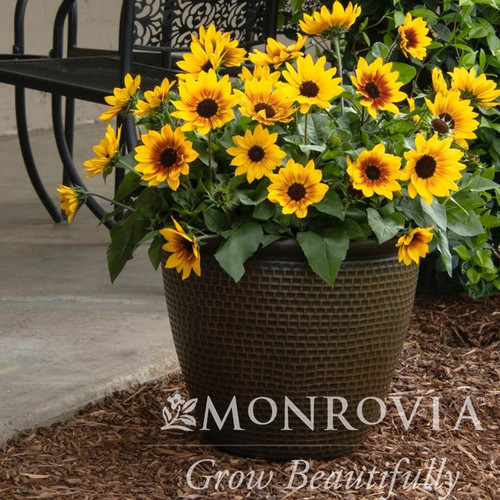
Sunflowers
Uses:
- Container
- Specimen or Focal Point
- Food Gardens
Features:
- Cut Flower
- Long Blooming
- Attracts Pollinators
Sunlight:
- Partial Sun to Full Sun
- At Least 5 Hours of Direct Sun
Growing Zones:
- 4-9
- What is My Zone?
True sunflowers (Helianthus) and false sunflowers (Heliopsis) are easy to care for and have a long bloom period. Most of these plants are native to North America and include both annuals and perennials. True sunflowers produce edible seeds or tubers and are often grown as a food crop. False sunflowers are cold hardy perennials with bright blooms that resemble sunflowers, but are usually grown for their ornamental value. Use these plants in garden beds, borders, and containers to attract pollinators and brighten an outdoor space.
About Sunflowers

Helianthus, Common Sunflower
North America
Annuals
Deciduous, Herbaceous
4 - 9
Yellow, Orange, Red, White, Bi-color, Purple/Maroon
Mid to late summer
Clumping, Upright
Bees, Butterflies, Hoverflies, Birds, Squirrels, Rabbits, Ladybugs, Caterpillars
Drought, Full Sun, Light Frost
Deer and Rabbits, Aphid resistance, Leaf spot disease resistance, Japanese beetles
How To Use Sunflowers In The Garden
Sunflowers (Helianthus) come in various sizes and display a warm palette of yellows, oranges, or reds with single or double petals. Their bold flower heads produce seeds that appeal to birds, while the pollen and nectar draw pollinators. Because they grow quickly and remain relatively carefree, sunflowers are often chosen to introduce children and novices to the joys of gardening.
Place tall types near fences or walls for a living screen and position shorter forms in borders or containers for long-lasting summer color. In meadow-style plantings, pair them with other sun-loving annuals or ornamental grasses to create natural focal points. Incorporate them into a pollinator-friendly space, and consider leaving spent heads as a source of seeds for wildlife. Harvest extra seed heads for indoor arrangements or roasting.
Types of Sunflowers
| Type | Scientific Name | Native Range | Flower | Main Bloom Time | USDA Zones | Uses | Features |
|---|---|---|---|---|---|---|---|
| Common Sunflower | Helianthus annuus | Western & Central U.S.; Canada to N. Mexico (widely naturalized) | Yellow, red, mahogany, white & bi-colors, 3–6 in. with brown-purple disc | July – Aug. (summer) | 2 – 11 (grown as annual) |
Annual beds, background screens, cut flowers, wildlife & seed crops, naturalizing | Heat & drought tolerant, deer resistant, attracts birds & butterflies, edible seeds |
| Willow-Leaved Sunflower | Helianthus salicifolius | South-Central U.S.; prairie pockets of Missouri | Bright yellow rays, dark-brown disc, 2–2.5 in. | Sept. – Oct. (late-season) | 4 – 9 | Prairie/meadow plantings, rear of borders, cutting gardens, naturalized screens | Showy fall color, butterflies & birds, deer & clay tolerant, feathery foliage, good cut stems |
| Ox-Eye (False) Sunflower | Heliopsis helianthoides | Central & Eastern N. America | Orange-yellow rays with brown center, 2–3 in. | June – Aug. (extends to Sept.) | 3 – 9 | Perennial borders, cottage & native gardens, meadows, cut flowers | Long bloom, drought & clay tolerant, attracts butterflies & seed-eating birds, good for erosion sites |
Sunflowers Care
Sunflowers require a location with at least 6 to 8 hours of direct sunlight daily and well-draining, slightly acidic to neutral soil. Sow seeds directly into the ground or containers after the last frost, planting them 1-2 inches deep and about a foot apart to reduce mildew risk. Water thoroughly upon planting and maintain moist soil until roots establish; thereafter, water when the top 1 to 2 inches of soil are dry. Initially, sunflowers benefit from nutrient-rich soil or compost; however, over-fertilizing can result in tall, leggy plants with fewer blooms.
Pruning is generally unnecessary for sunflowers, but removing spent blooms can promote additional flowering. For winter care, cut back foliage after it has turned brown and crispy. When growing sunflowers in containers, choose a pot that accommodates the root ball and use a well-draining potting mix rich in organic matter. Sow seeds directly into the container and thin out seedlings to prevent overcrowding.
Learn More About Sunflower Care

Growing Sunflowers From Seed
Where should I sow my sunflower seeds?
Tips on soil, sunlight, and moisture levels.
What types of pots work best for growing sunflowers?
Sunflowers Companion Plants
Give sunflower companions a position with at least six hours of direct light, moderately fertile soil that drains well, and steady moisture during hot spells. In spring, weigela’s bell‑shaped blossoms and variegated foliage carry the color show while young sunflowers bulk up, and low, daisy‑styled shasta daisies weave a cohesive carpet beneath the taller stalks through midsummer. As temperatures climb, spreading tickseed echoes the yellow palette and feeds pollinators at the same time that upright snapdragons supply contrasting spires and extend bloom into early autumn.


















